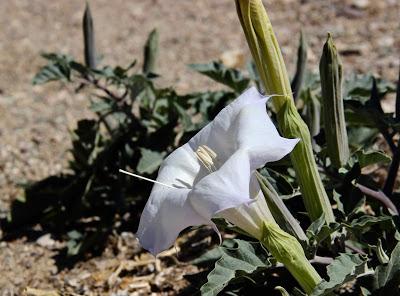
In a disturbed land cleared of life and showered with trash, sacred datura stands in regal glory. She thrives next to heat-radiating asphalt, fully illuminated by the sun and soaking up the rare runoff. At dusk, when the searing heat of daytime subsides, she opens great white trumpet-shaped flowers to welcome night visitors. The large fragrant patches of white, conspicuous even in the dim light, are produced for one reason—sex. Datura may be sacred but she’s hardly celibate.
Her lure is irresistible. Hawkmoths flit from flower to flower, feeding on copious nectar deep in the throat, bumping anthers, picking up pollen. Then at the next flower(1), a moth brushes against the receptive stigma waiting at the opening, leaving behind a few grains. Within minutes pollen tubes grow down the style, and male gametes make the long journey to fertilize ovules. With seed development, the ovary matures into a large plump spine-covered seed pod—a “thorn apple.”

Datura wrightii can grow to 3 feet in height, with flowers up to 8 inches long.

Bud and flower (beginning to wilt at 9 AM, 75º F).

Flower in bud. When the time is right, it will unroll and turn white.

Exserted stigma waits for pollen, at the tip of a very long style; anthers visible at top of throat.


With age, sacred datura becomes the thorn apple (source).
In winter, if temperatures fall well below freezing, sacred datura disappears—or so it seems. But she’s only dormant, resting underground as large fleshy tuberous roots until spring. Then she rises again.
Sacred datura’s mighty root (source).
Sacred datura’s beautiful fragrant flowers, though clearly worthy, do not explain the widespread reverence she commands. Something much more exotic attracts worshippers—her powers of prophecy, divination and healing. Indigenous peoples throughout northwest Mexico and the southwest US have taken advantage of datura’s psychoactivity. In her early study of the California flora, Mary Elizabeth Parsons noted that “they [California Indians] administer it to their young dancing women as a powerful stimulant, and before going into battle the warriors take it to produce a martial frenzy in themselves” (Parsons 1907). In several cultures, boys were given datura as part of initiation into manhood (Fuller 2000). They fell into unconsciousness, which destroyed all memories of childhood (and sometimes the initiates as well), and then were taught the stories, traditions and rituals of their tribe.Shamans, mystics and seekers continue to worship datura (2), even though it’s among the most dangerous of vision-inducing plants. All parts contain deadly tropane alkaloids—atropine, hyoscyamine, and hyoscine. Safe dosage is difficult to determine because individual plants vary in potency, humans differ in tolerance, and the onset of noticeable effects is slow. Cases of datura poisoning, including death, are usually due to deliberate consumption (source). Survivors can be temporarily or permanently scarred—with damaged lungs, stomach, intestines, kidneys and/or heart, and perhaps blindness and mental impairment.Yet there will always be people willing to risk datura’s dangers for her promises—sufferers and seekers, lost souls and spiritual adventurers, thrill-seekers and those hoping to see beyond what we’ve been programmed to perceive. I suspect that as long as humans exist, sacred datura will be a “plant of the gods.”
Original source unknown.
Footnotes(1) Datura wrightii is self-compatible—fertilization does not require pollen from a separate plant. But pollinators are helpful. Visiting hawkmoths have been shown to increase rates of self-pollination as well as outcrossing (Bronstein 2009).(2) Datura wrightii is native to southwest North America, not just on roadsides but also in other open sandy habitat, e.g. desert washes. Its close relative, Datura stramonium, is the similarly-revered jimsonweed. Datura belongs to the nightshade family (Solanaceae), as do many other plants that offer us pleasure, poison, or both—chilis, petunias, potatoes, tomatoes, tobacco, belladonna, deadly nightshade and more.Sources
Bronstein, JL, et al. 2009. Reproductive biology of Datura wrightii: the benefits of a herbivorous pollinator. Annals of Botany 103: 1435–1443. doi:10.1093/aob/mcp053Fuller, RC. 2000. Stairways To Heaven: Drugs In American Religious History. Basic Books.Parsons, ME. 1907. The wild flowers of California. Dover Books (1966).Schalau, J. 2015. Backyard Gardener: Sacred Datura. Arizona Cooperative Extension, Yavapai County.https://cals.arizona.edu/yavapai/anr/hort/byg/archive/sacreddatura2015.html
